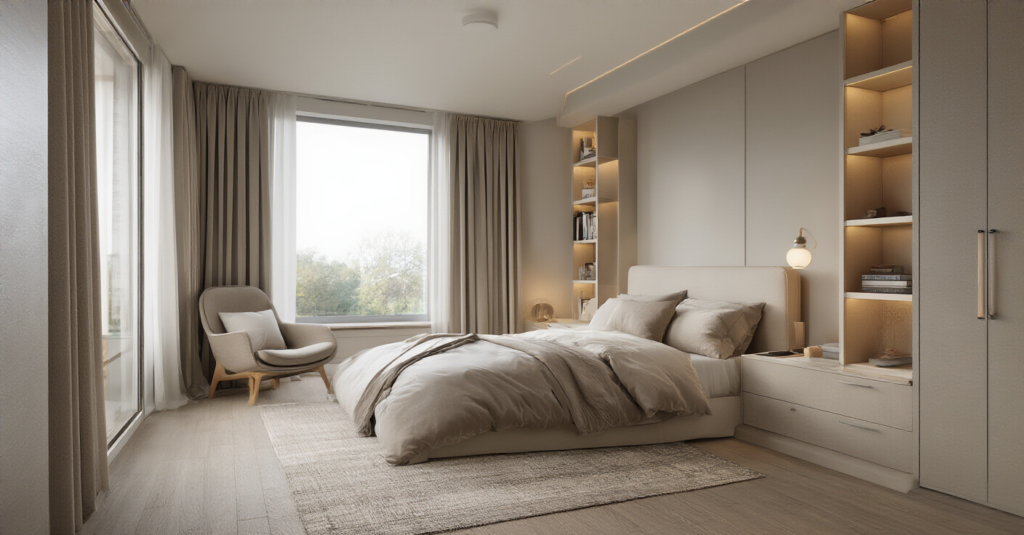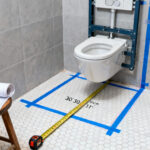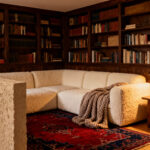Picture this: You’ve just finished your dream bedroom remodel. It’s gorgeous. You have that cream-colored boucle chair you saved for, dramatic floor-to-ceiling drapes, and a super-plush, high-pile wool rug that feels like heaven under your feet. You sink into your new bed, feeling blissful. And then you hear it. The unmistakable hork-hork-hork sound of your golden retriever preparing to redecorate that heavenly wool rug with last night’s dinner.
Suddenly, that sanctuary feels more like a crime scene. Everyone thinks creating a beautiful bedroom means choosing between style and their pet. That’s the biggest misconception out there. As a vet tech who spends her days designing homes, I can tell you that you absolutely do not have to live with scratched-up furniture and stained floors to have a pet. You just need to design smarter. A true sanctuary is a place where every member of your family feels safe and comfortable, including the ones with paws and tails. Let’s talk about how to actually do that.
Laying the Groundwork: Planning & Vision
Before you so much as look at a paint chip, you need a plan. And not just any plan—a plan that accounts for zoomies, sharp claws, shedding, and the occasional “oops.” This is where you save yourself heartache (and money) down the line by thinking about your pet’s life, not just your aesthetic goals.
1. Define Your Bedroom’s Desired Style and Function
People always start with style. “I want a Japandi, minimalist, coastal-grandma vibe!” That’s great, but let’s get real. How does your 80-pound Lab, Bartholomew, use the room? The first question I ask clients is “What does your pet do in here?” Your bedroom isn’t just for sleeping; for them, it might be a racetrack, a sunbathing spot, or a safe place to hide during thunderstorms. The real function of the room dictates its form.

So, instead of just a mood board, do a ‘Pet Lifestyle Audit.’ Does your cat need a high perch to feel secure? Is your senior dog arthritic and needs a clear, non-slip path from the bed to the door for midnight potty breaks? One client’s ‘aha’ moment came when we realized her anxious rescue dog needed a cozy, den-like space. We integrated a built-in “dog cave” into her new wardrobe, complete with a comfy bed and his favorite blanket. It looked intentional and stylish, but more importantly, it gave him a secure haven. Function first. Always.
Once you know how the space needs to work for everyone, you can move on to the money part.
2. Set a Realistic Budget and Track Renovation Costs
When most people budget, they think about paint, furniture, and labor. When a pet owner budgets, they need to add a line item called “The Pet Factor.” This isn’t just a contingency fund for ‘what-ifs’; it’s for the ‘when-it-inevitably-happens.’ This means budgeting for performance fabrics that cost more upfront, for scratch-resistant flooring, and maybe for a professional, pet-safe deep clean after the renovation is done.

I learned this the hard way myself. Years ago, I installed beautiful, dark hardwood floors, thinking they looked so chic. What I didn’t budget for was how every single speck of my golden retriever’s fur would show up. Or how his nails would sketch a permanent map of his zoomie paths across the finish. Underestimating these costs is the biggest mistake. Instead of a vague 15% contingency, get specific. Price out that Crypton fabric sofa. Look at the cost difference between standard laminate and luxury vinyl plank flooring. That’s not overspending; it’s a smart investment in your peace of mind.
With a budget that reflects your reality, you can start mapping out the space.
3. Develop an Optimal Floor Plan for Space Efficiency
An optimal floor plan isn’t just about making a room feel bigger; it’s about making it safer and more comfortable for your pets. Before you move a single piece of furniture, get down on the floor and see the room from their perspective. Is there a clear, wide path for them to get around? Or is it an obstacle course of furniture legs that your older dog might bump into in the dark?
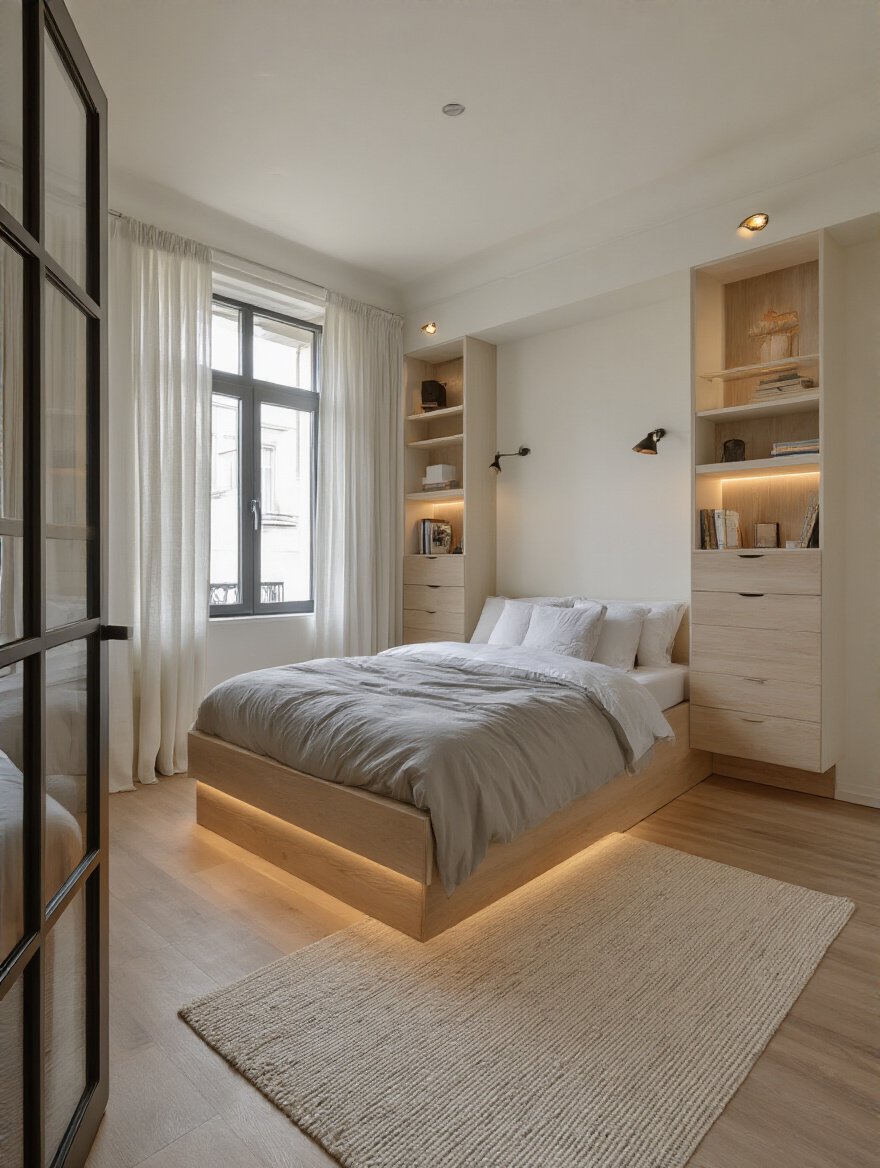
I always tell my clients to plan for ‘runways’ and ‘refuges.’ A runway is a clear path for play, especially important for energetic dogs. A refuge is a designated safe spot for your cat or a timid dog, like a corner with a cozy bed that’s out of the main foot-traffic path. For a client with a cat and a dog, we designed a layout with verticality in mind. We placed the bed to allow for a clear floor space, but also added a tall cat tree in a corner and sturdy floating shelves that became a “cat highway,” giving the cat a way to navigate the room without ever touching the dog’s domain. It created harmony, and it’s a shortcut I wish I’d known earlier: designing for peace between pets is just as important as the human traffic flow.
Now that the flow is right, let’s make sure the vibe is right, too.
4. Gather Inspiration and Create a Cohesive Design Board
Go ahead and use Pinterest, but use it with a pet-proof filter on your brain. As you pin those gorgeous images, ask yourself: “What would my cat do to that woven-jute headboard?” or “How long would that white silk pillow last after a muddy-paw cuddle session?” The BS part of a lot of design inspiration is that it’s created for a world where no one has pets or kids. It’s staged and sterile.
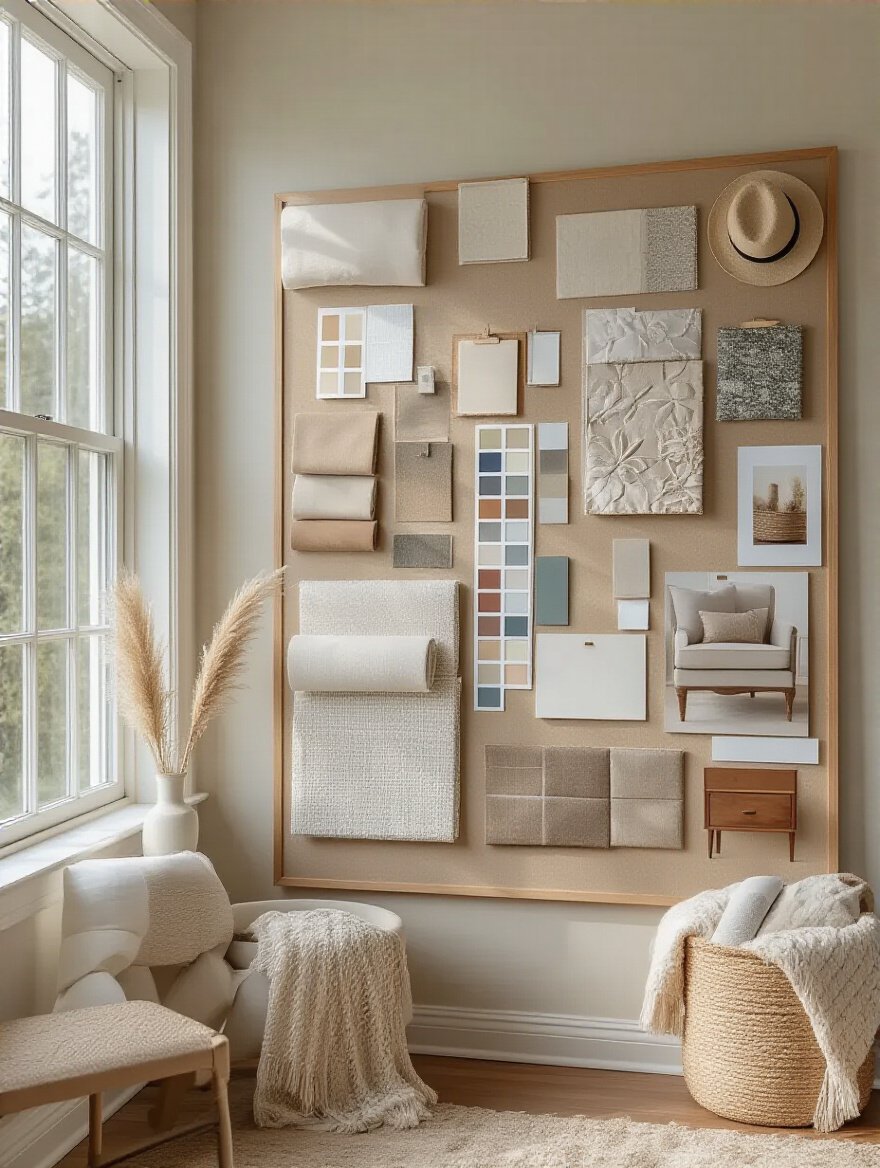
Your design board should be more than just pretty pictures; it should be a collection of textures and materials. Order samples! Get a swatch of that performance velvet, a sample of the luxury vinyl plank, a paint chip. Lay them all out together. One of my favorite tricks is to take my dog’s favorite toy—a bright orange ball—and place it on my design board. If the overall look can handle a neon orange ball without looking completely insane, you’re on the right track. It’s a great reality check to ensure your “sanctuary” can still feel like home when it’s actually being lived in.
Before you buy any of that beautiful stuff, we need to check under the hood.
5. Assess Existing Electrical and Structural Needs Proactively
For most people, this step is about making sure they can add a chandelier. For us, it’s about preventing a trip to the emergency vet. Do you know what’s irresistibly chewy to a puppy or a bored cat? A loose electrical cord. When you assess your electrical needs, you’re not just counting outlets; you’re hunting for hazards.
Look for any dangling cords from lamps or TVs. Plan to move outlets to be behind furniture or to install recessed outlets so plugs sit flush with the wall. One of the best things you can do is plan for built-in solutions. During a remodel, it’s relatively cheap to have an electrician install an outlet inside a nightstand drawer. This creates a hidden charging station, so your phone and watch chargers aren’t just lying out, tempting fate. I worked with a family who had spent nearly a thousand dollars on vet bills after their beagle chewed a live lamp cord. A few hundred dollars spent on a thoughtful electrical plan up front is an investment in your pet’s safety. Full stop.
Core Aesthetic Transformations
Okay, the groundwork is laid. Now for the fun part: making it pretty. But pretty for us means beautiful, durable, and safe. These are the choices that will define your room’s character and determine whether it’s a true haven or a constant source of anxiety.
6. Select the Perfect Wall Color to Set the Mood
The color of your walls does more than set a mood for you; it needs to withstand the reality of your pets. My advice? Forget flat or matte finishes. They look beautiful for about five minutes until the first wet nose, muddy tail, or oily patch of fur brushes against them. You will never, ever be able to wipe it clean without leaving a shiny spot.
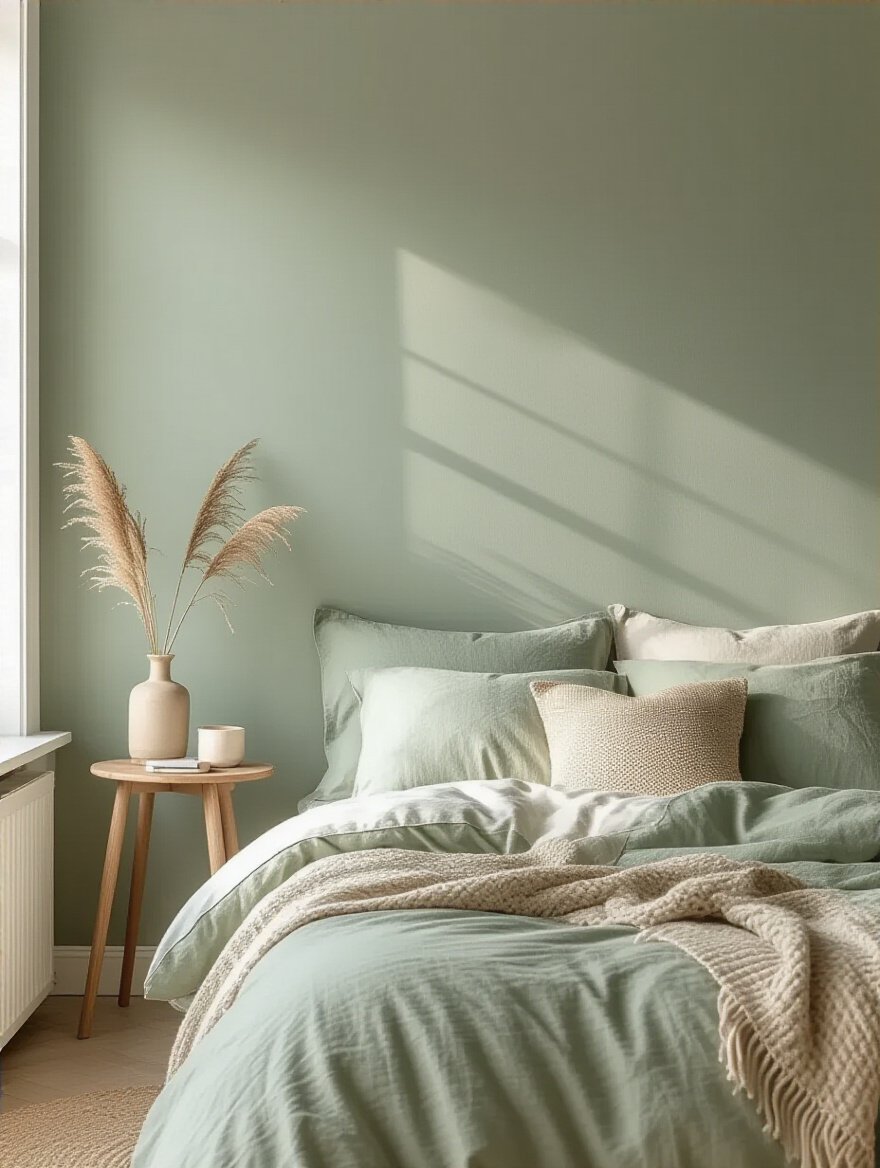
Instead, go for an eggshell or satin finish. These have a slight sheen that makes them dramatically more durable and scrubbable. When it comes to color, think strategically. That pristine white wall might look great on Instagram, but it will highlight every single dark hair. I often suggest colors with a bit of depth or warmth—think greiges, muted greens, or soft blues—that are more forgiving. And always, always choose a low-VOC or zero-VOC paint. Pets, with their faster metabolisms and proximity to the floor, are more sensitive to the chemicals released from fresh paint. It’s a simple switch that makes the air healthier for everyone.
Once the walls are coated in a durable, pet-friendly color, we need to address what’s underfoot.
7. Upgrade Flooring for Enhanced Comfort and Durability
Can we talk about the biggest mistake everyone makes with bedroom flooring? They choose something that looks good but is a nightmare for pets. High-pile carpet with looped fibers? It’s a nail-snagging deathtrap for cats and some dogs. Polished, slippery hardwood? It’s like a skating rink for a senior dog with hip dysplasia, and every single claw mark will show.
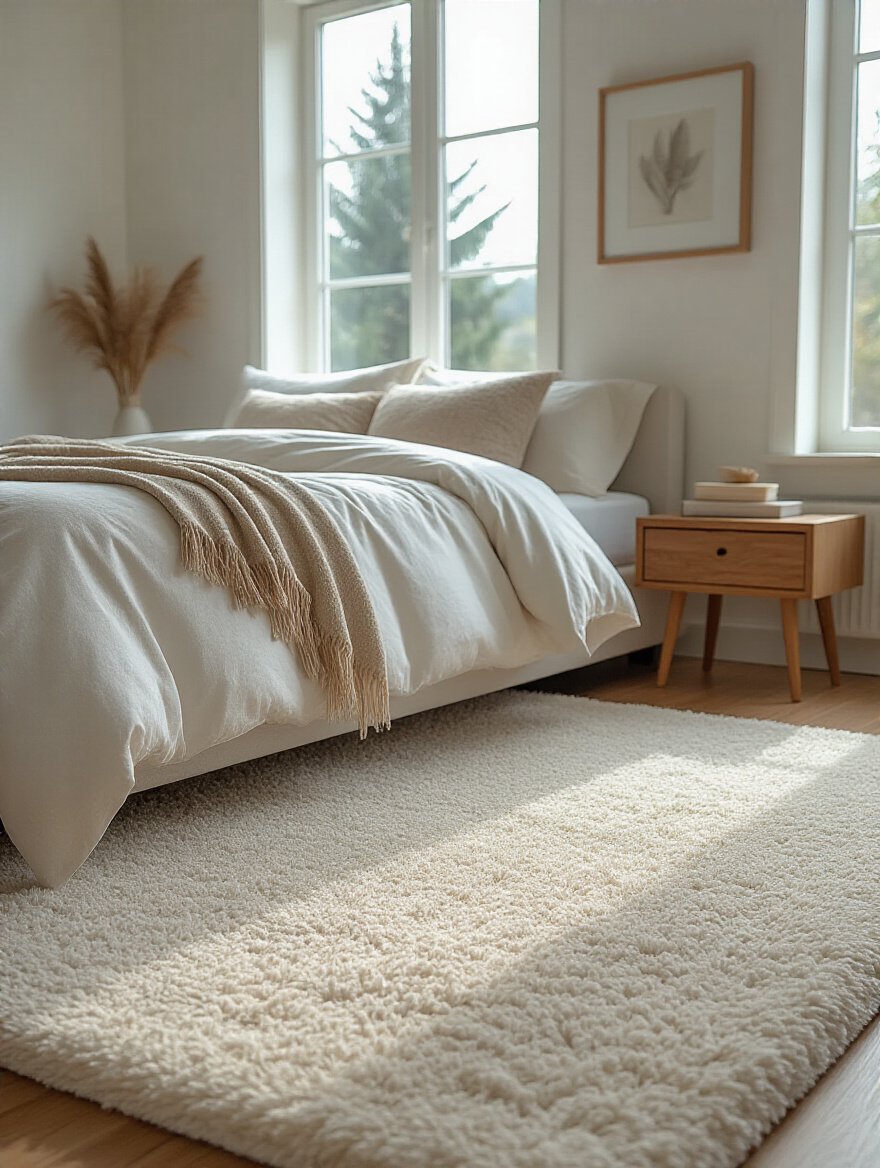
Your flooring needs to have three things: scratch resistance, slip resistance, and stain resistance. My top recommendation is almost always luxury vinyl plank (LVP). It’s virtually indestructible, waterproof (hello, puppy accidents!), and has a bit of texture for grip. If you love soft surfaces, opt for a tightly woven, low-pile carpet made from solution-dyed fibers (like nylon or polypropylene) which have the stain resistance built right in. A shortcut I swear by is carpet tiles. If a section gets permanently stained, you can just pop it out and replace that one tile. It’s a game-changer.
After you’ve got the ground covered, look up to the windows.
8. Optimize Natural Light with Modern Window Treatments
Puddles of sunlight are a non-negotiable for most cats and dogs. But window treatments can be one of the biggest hidden dangers in a home. Those long, dangling cords on traditional blinds are a serious strangulation hazard. I’ve heard absolute horror stories from my vet tech days. This is a non-negotiable: go cordless. Always.
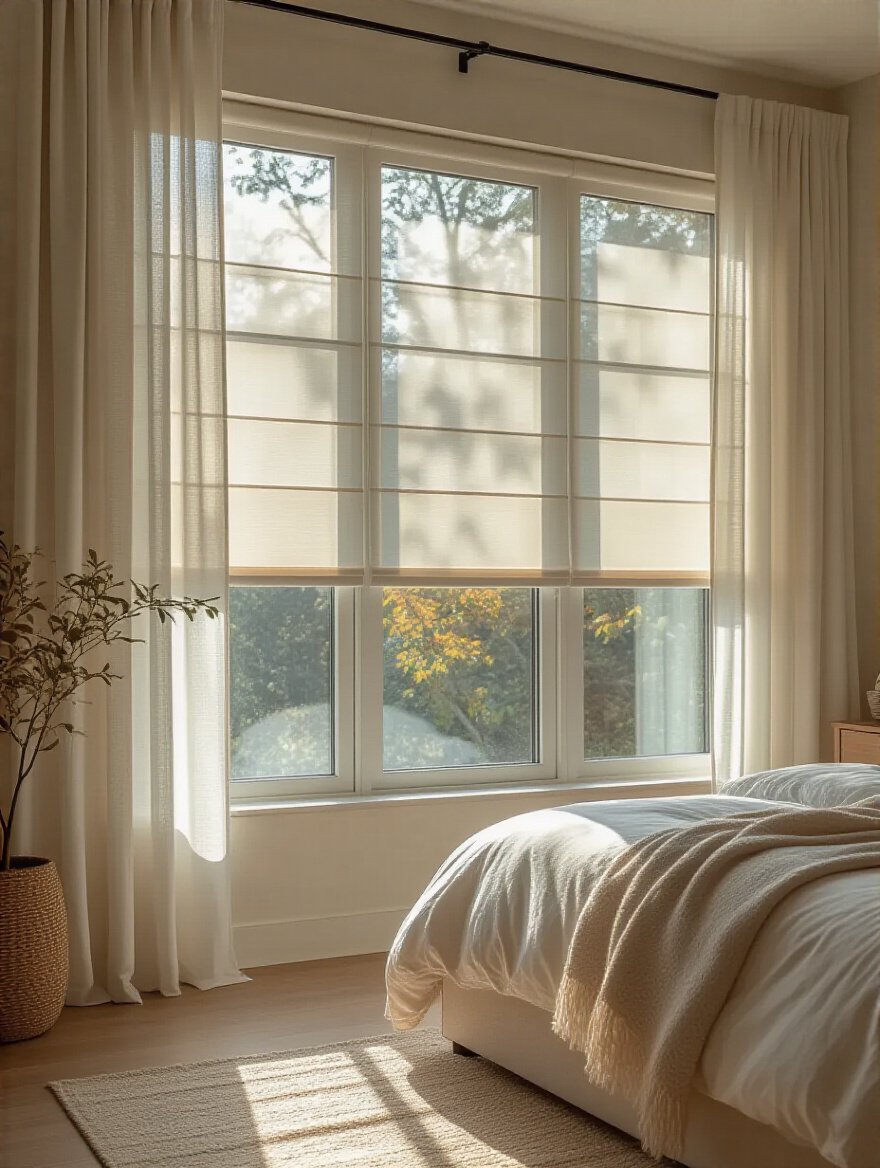
Modern options make this easy. You can get cordless cellular shades, wands for blinds, or—my personal favorite—motorized smart shades. You can set them on a schedule to open in the morning (letting your pet find their favorite sunbeam) and close at night for privacy. For fabric, think durable. Avoid delicate silks or linens that a cat will see as a personal climbing wall. Instead, opt for sturdy woven fabrics, wood, or faux-wood blinds that can withstand a curious paw or two.
Next, let’s talk about the unsung hero of pet-friendly design: layered lighting.
9. Implement Layered Lighting for Ambiance and Task Focus
Good lighting is more than just a vibe; for older pets, it’s a safety feature. As dogs and cats age, their vision deteriorates, and they can develop something similar to dementia called Canine Cognitive Dysfunction. They can get confused or anxious in the dark. A single, harsh overhead light creates deep shadows that can be disorienting for them.

Layering your lighting helps solve this. Have your soft, ambient overhead light on a dimmer. Add task lighting, like a reading lamp by your bed. But the real shortcut is to add a third, low-level layer of light. This could be subtle LED strip lighting under your Bed Frame or along the baseboards, controlled by a motion sensor. It provides a gentle, soft glow so if your senior pet needs to get up in the middle of the night, they can see where they’re going without being startled by a bright light. It’s a compassionate detail that makes a world of difference for them.
Want to add even more visual interest? Let’s talk feature walls.
10. Design an Impactful Feature Wall for Visual Interest
A feature wall is a fantastic way to add personality, but your first thought should be: “Is this scratchable?” That beautiful, textured grasscloth wallpaper? To your cat, it is the world’s most expensive scratching post. The same goes for some raw-wood or fabric-paneled walls.
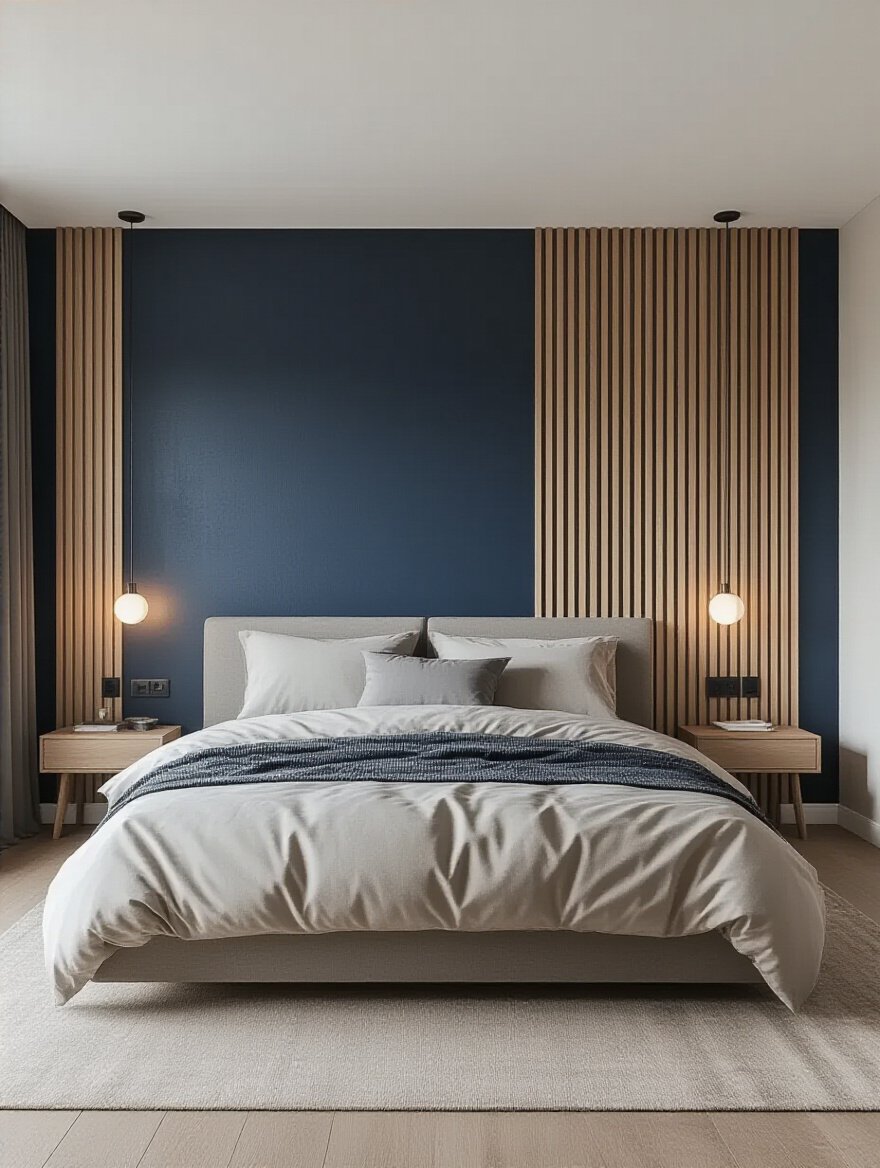
Instead, think about textures that are inherently durable. Shiplap or board-and-batten is a fantastic option. It adds incredible architectural detail, and if it gets scuffed, you can just touch it up with paint. Limewash or Roman clay finishes are also great because their natural, mottled texture hides minor imperfections. And here’s a tip: a feature wall is the perfect place to build in a “cat superhighway.” You can install a series of stylish floating shelves that are both a decorative element and a climbing paradise for your feline friend, giving them a vertical space to call their own.
And for an easy win that polishes the whole look, let’s look at the little details.
11. Replace Outdated Doors and Trim for a Polished Finish
You might not think doors and trim are a “pet” issue, but just look at the bottom of the door frame by your bedroom. See those little scratches? That’s from years of your dog asking to go in or out. Outdated, flimsy trim gets dinged up easily, and hollow-core doors offer zero sound insulation—which is terrible if you’re trying to sleep while your dog is barking at a squirrel outside.
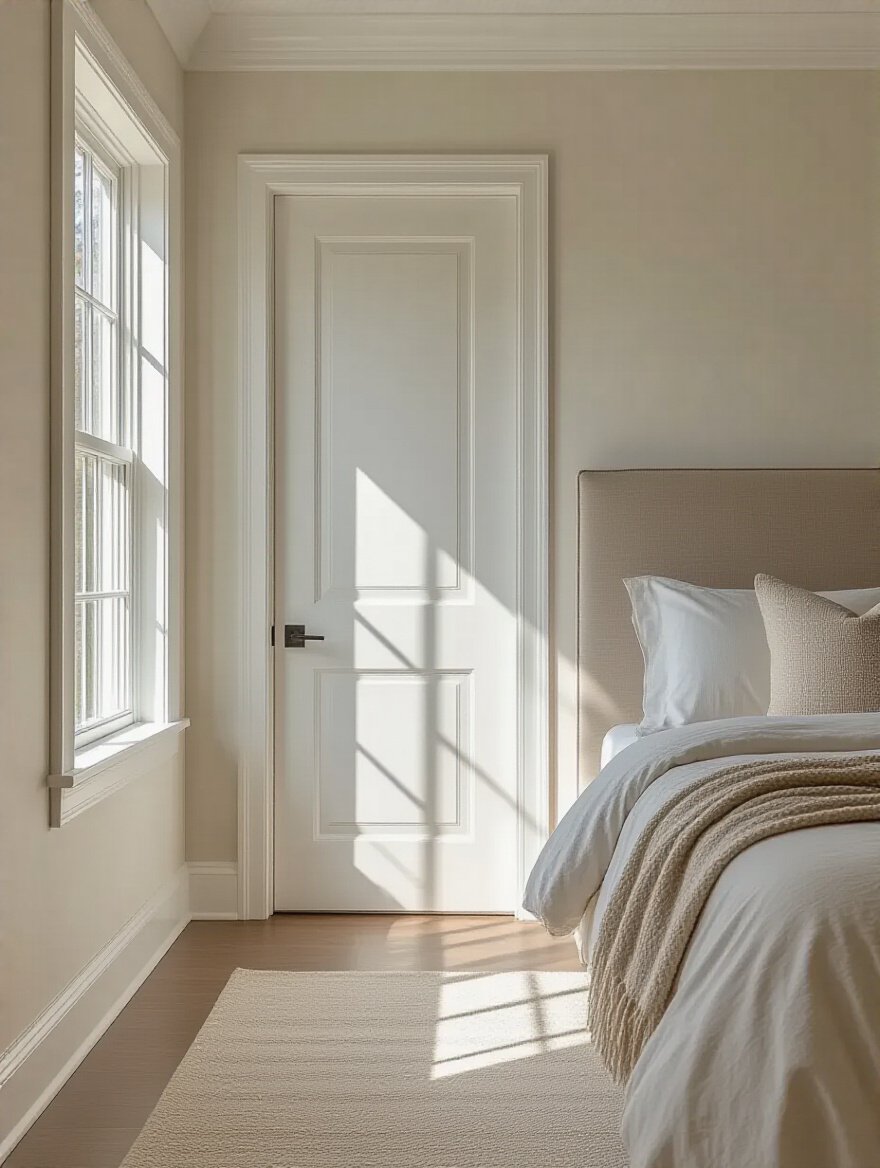
Upgrading to solid-core doors is one of the best investments you can make. The heft feels luxurious, but more importantly, it muffles sound significantly, creating a quieter, more peaceful sanctuary. When choosing trim, go for a durable solid wood or MDF profile rather than cheap composites. And here’s a pro tip: use a semi-gloss paint finish on your trim. It’s the toughest finish available and will stand up to wiping down paw prints and scuffs for years to come. It’s a small change that makes the entire room feel more custom and intentional.
Enhancing Functionality & Smart Solutions
Now we’re moving beyond just aesthetics to things that make your life genuinely easier. A truly smart home isn’t just about tech; it’s about clever solutions that reduce clutter and stress for both you and your furry family.
12. Install Built-In Storage to Maximize Vertical Space
The best way to pet-proof your bedroom? Get things off the floor. Shoes, bags, books, phone chargers—if it’s within reach of a curious puppy, it’s a potential chew toy (and a potential vet bill). Freestanding bookshelves or open cubbies just aren’t going to cut it.
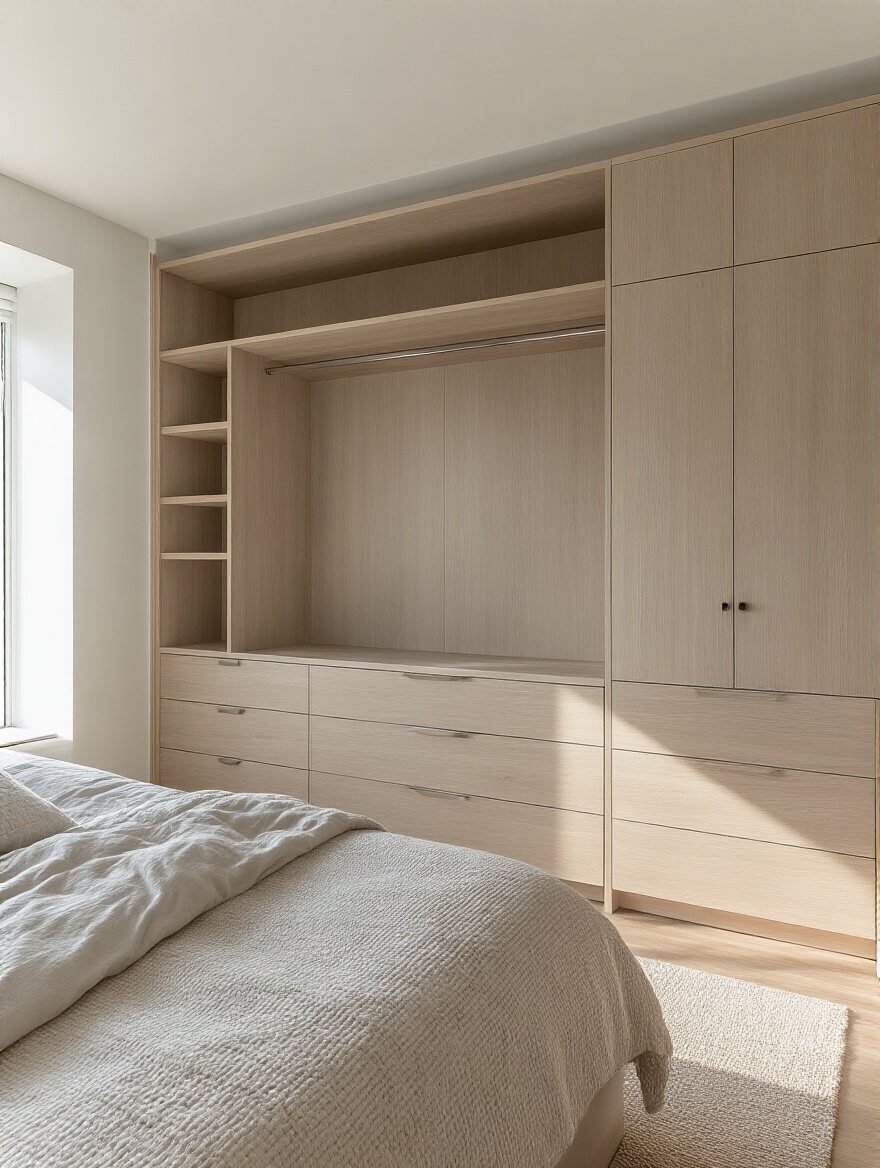
Built-in, floor-to-ceiling storage is the ultimate solution. It allows you to create designated, closed storage for everything. A wall of custom wardrobes can hide all your clothes and shoes behind closed doors. A built-in window seat can have deep drawers underneath for storing extra blankets and dog toys. My favorite trick is to incorporate the pet’s space directly into the built-ins. Think of a niche at the bottom of a bookshelf designed to perfectly fit your dog’s bed. It looks incredibly chic and intentional, and it keeps their bed from floating aimlessly in the middle of the room.
To make that built-in storage even more effective, you need a system.
13. Create a Highly Organized and Efficient Closet System
A chaotic closet often spills out into the bedroom, creating the kind of clutter that pets love to get into. Think of a pile of clothes on the floor as an open invitation for a cat to make a nest (and shed all over your clean laundry) or for a dog to find a new sock to chew. A well-organized closet keeps your stuff safe and your room serene.
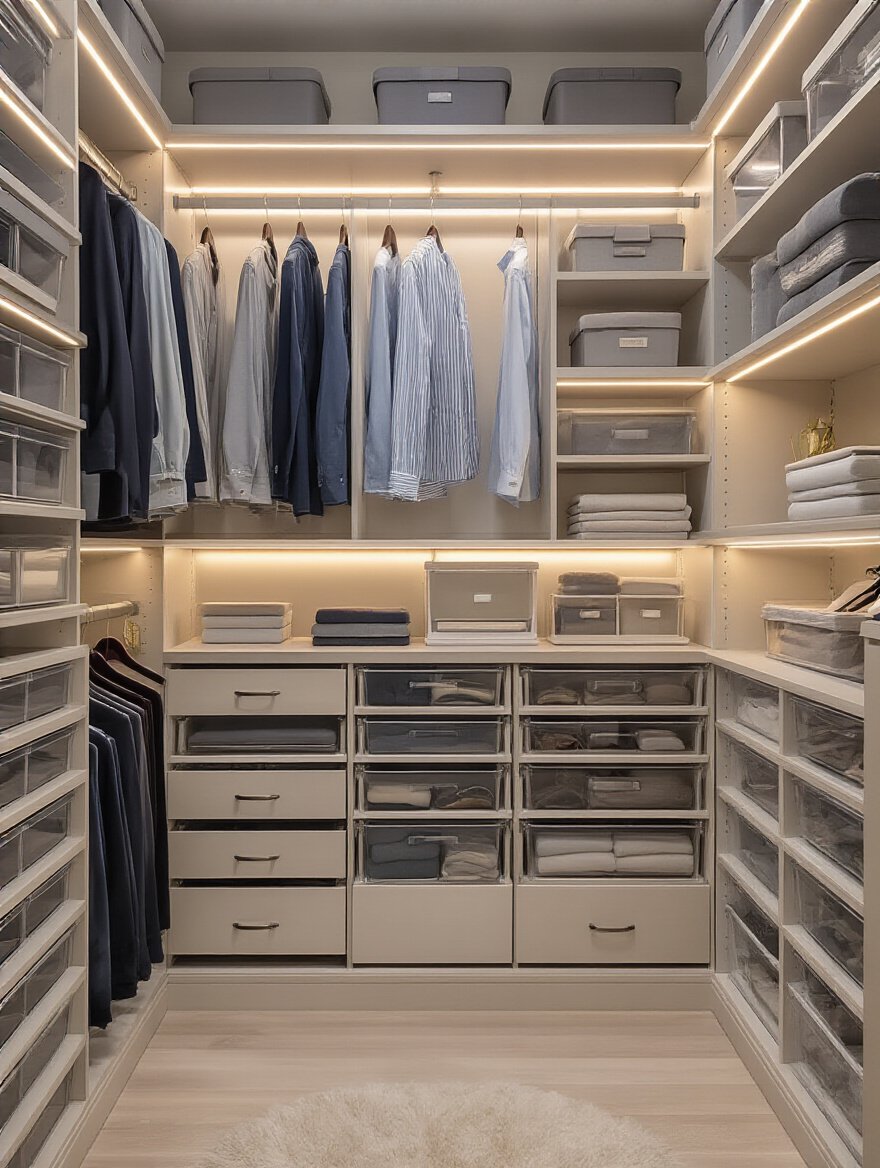
This is less about the pets themselves and more about how their presence demands a higher level of organization from you. Invest in a system with plenty of drawers and covered bins. This is key for keeping things you don’t want covered in fur—like your work clothes or delicate sweaters—protected. I also recommend a closed laundry hamper inside the closet. An open basket of dirty clothes is just too tempting for a dog who loves to steal socks. A good system isn’t a luxury; it’s a necessity for maintaining order in a pet-filled home.
Next, let’s talk about the clutter that drives me the craziest: cords.
14. Integrate Hidden Charging Stations for Device Management
A tangled mess of charging cables on your nightstand isn’t just ugly; it’s a legitimate hazard for your pets. I’ve seen too many cats and dogs chew through cords, risking electrocution or intestinal blockages if they swallow pieces. Getting those cords out of sight is a critical safety measure.
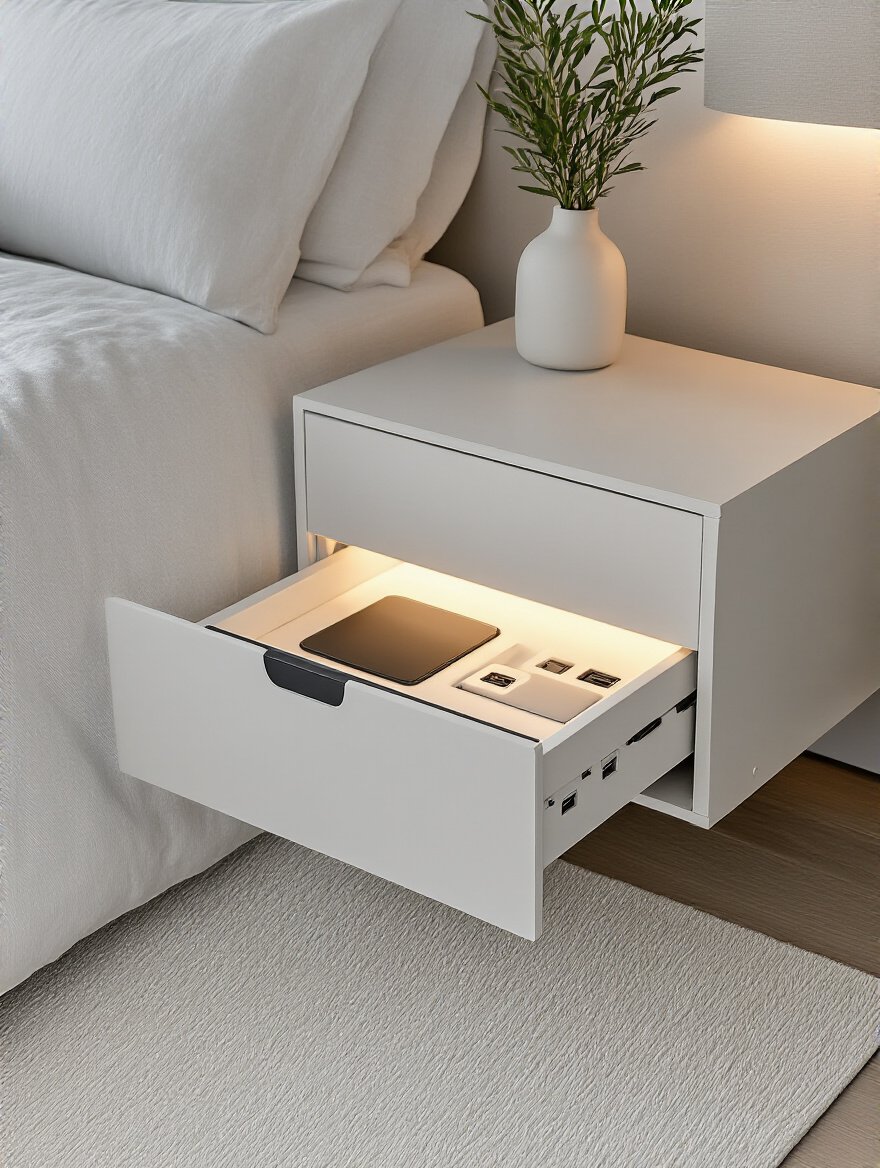
This is where thoughtful design comes in. During your remodel, ask your electrician to install an outlet inside a drawer of your nightstand. You can plug a power strip in there and have a permanent, hidden charging hub. If that’s not possible, look for nightstands that have built-in cord management holes in the back. You can also buy grommets online and drill a hole yourself. The goal is to have zero accessible, dangly cords. It’s one of the most effective things you can do to make your bedroom safer.
And while we’re making things safer, let’s make them quieter, too.
15. Soundproof Walls or Doors for Quieter, Private Sleep
Do you have a dog that barks at every leaf that blows past the window? Or a cat who decides 3 a.m. is the perfect time to sing the song of their people? A lack of soundproofing can make getting a full night’s sleep feel impossible. And it goes both ways—if you have guests over, a soundproofed room gives your pet a quiet place to retreat from the noise.

There are levels to this. The simplest step is replacing your hollow-core bedroom door with a solid-core one and adding a door sweep to the bottom—this alone can make a huge difference. You can also hang heavy, thick curtains or add a large, plush area rug, as soft surfaces absorb sound. For a bigger impact, you can add an extra layer of drywall with a sound-dampening compound like Green Glue in between. For my clients who are extremely light sleepers or have very vocal pets, this is an investment that pays for itself in sleep quality.
Now, let’s bring in some tech to make life even easier.
16. Incorporating Automated Blinds for Smart Light Control
This might seem like a pure luxury, but for pet owners, it’s incredibly practical. Remember how we talked about going cordless for safety? Motorized blinds are the ultimate cordless solution. There are zero cords for a pet to get tangled in, making them the safest option available.

The “smart” part is a bonus. You can program your blinds to open and close on a schedule. This is fantastic if you work long hours—you can program the blinds to open in the afternoon so your sun-loving cat can have their daily sunbath, even when you’re not home. For anxious dogs who bark at everything they see, you can program the blinds to close before you get home, creating a calmer environment for your return. It’s a bit of an investment, but the safety and convenience are undeniable.
Adding Comfort, Style & Personal Touch
Your bedroom’s bones are now strong, functional, and safe. Now, let’s infuse it with the soul. This is about layering in the cozy, personal elements that make a room feel like a hug—for you and for them.
18. Invest in Premium Bedding for Ultimate Sleep Comfort
You want bedding that feels luxurious, but it also needs to stand up to claws, fur, and the occasional need to be washed on the “sanitize” cycle. The biggest BS in the bedding world is high-thread-count cotton. While soft, the fine threads can easily be snagged by a dog’s or cat’s claws, creating pulls and tears.
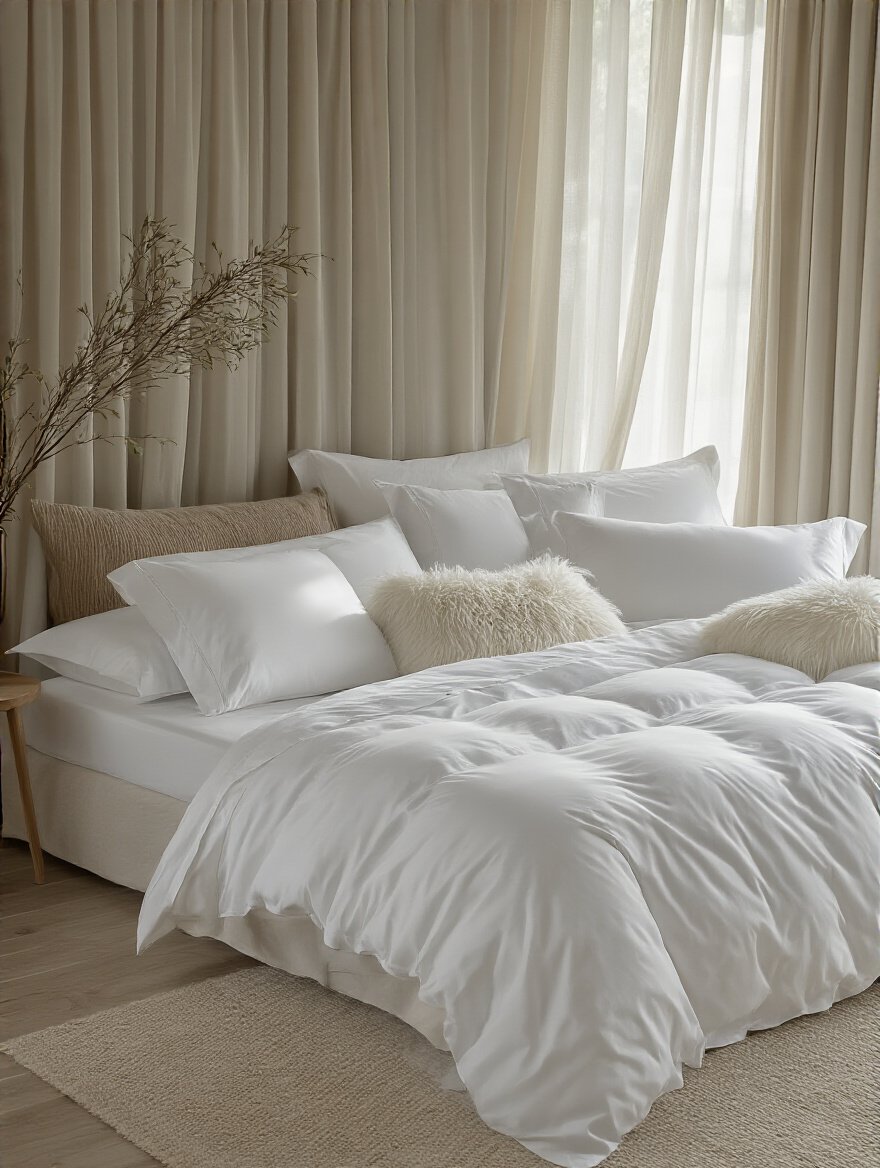
My shortcut is to look for a different kind of quality. A sturdy linen or a durable cotton percale will actually get softer with every wash and is much less prone to snagging. For color, avoid anything too light unless you enjoy using a lint roller as a daily accessory. And my biggest tip: always use a duvet cover. It’s so much easier to strip and wash a duvet cover than to try and cram a giant comforter into your washing machine after a muddy-paw incident. And get a waterproof Mattress Protector. It’s not sexy, but it is a non-negotiable for protecting your mattress investment.
The cozy layers shouldn’t stop at your bed.
19. Introduce Layered Textures with Rugs and Throws
Texture makes a room feel rich and inviting. But for a pet owner, texture can also mean “hard to clean.” That beautiful, chunky knit throw? It’s a magnet for pet hair. A high-pile shag rug? Good luck getting a hairball out of that.
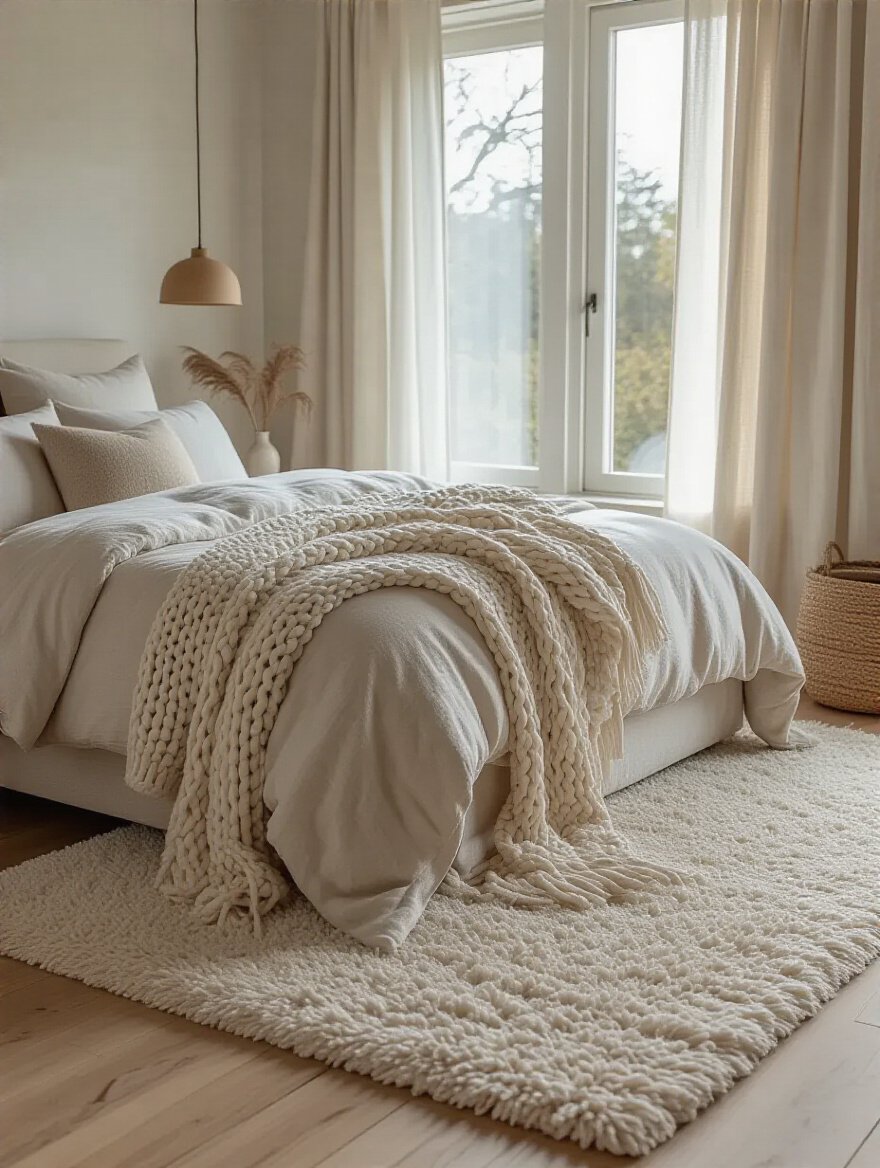
The key is to choose your textures wisely. Look for rugs that are low-pile and made of durable, cleanable materials like wool or synthetics. Throws made from washable materials like cotton, or performance fabrics like fleece or microfiber are great choices. I love using washable faux-fur throws—they look incredibly luxurious, pets love to snuggle on them, and you can just toss them in the wash. This way, you get all the cozy, layered goodness without the cleaning nightmare.
With the textures in place, let’s bring in things that are uniquely you.
20. Curate Personalized Art and Decor That Inspires
Your art and decor should tell your story. And for most of us, our pets are a huge part of that story. Why not celebrate that? Instead of generic art from a big box store, consider commissioning a custom pet portrait. There are amazing artists on sites like Etsy who can create beautiful, modern portraits of your furry family member that feel like genuine works of art.
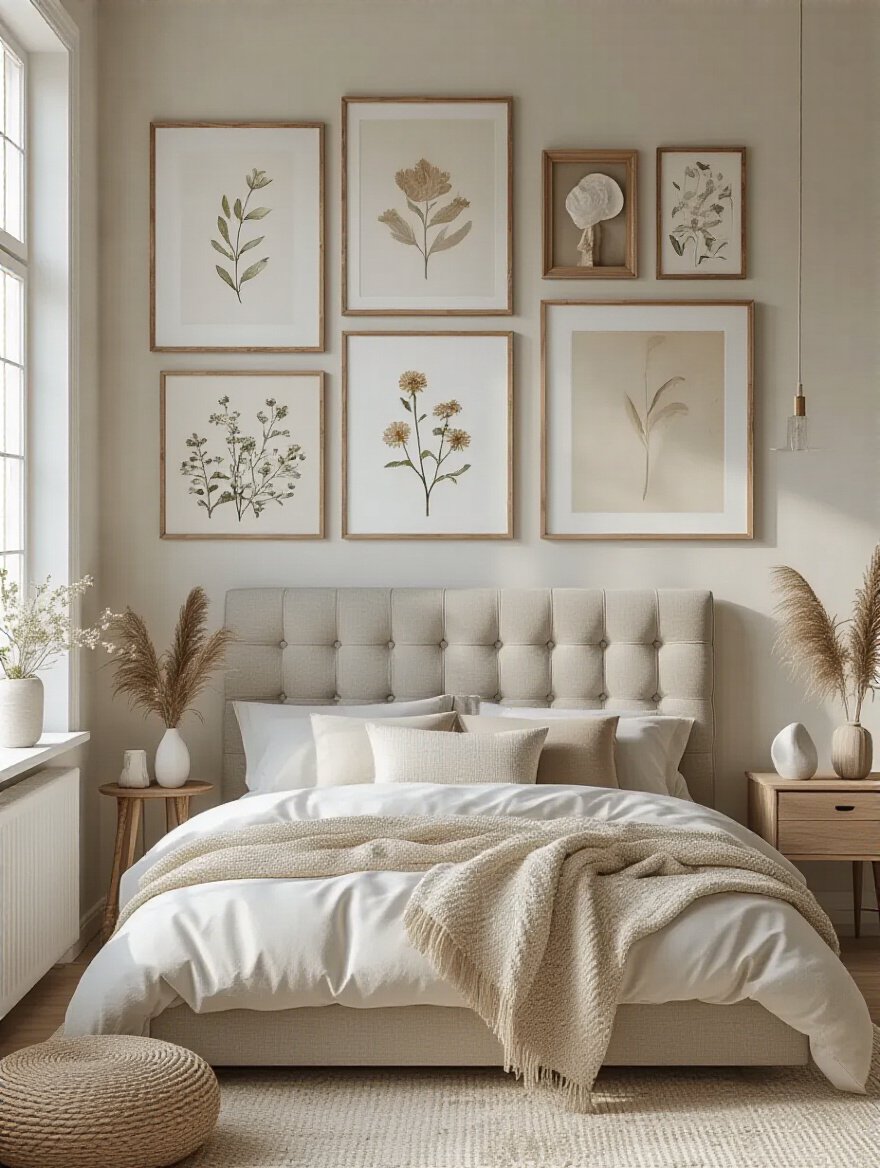
When displaying decor, think about height. If you have a cat with a curious tail (aka a “gravity-testing wand”), fragile items need to be placed on high, stable shelves, or secured with a little museum wax on the bottom. One of my favorite things to do is create a gallery wall that mixes family photos, travel pictures, abstract art, and beautiful photos of our pets. It makes the space feel so personal and joyful.
And speaking of joy, let’s bring some life into the room.
21. Select Calming Indoor Plants to Boost Well-Being
Okay, can we have a serious talk? This is the single most important thing I can tell you as a vet tech. The original article this was based on suggested Peace Lilies. Peace Lilies are toxic to cats and dogs. So are many other common houseplants, like Snake Plants, ZZ Plants, and all types of true lilies. Before you bring a single plant into your home, you must check the ASPCA’s list of toxic and non-toxic plants. It’s not a suggestion; it’s a life-or-death responsibility.
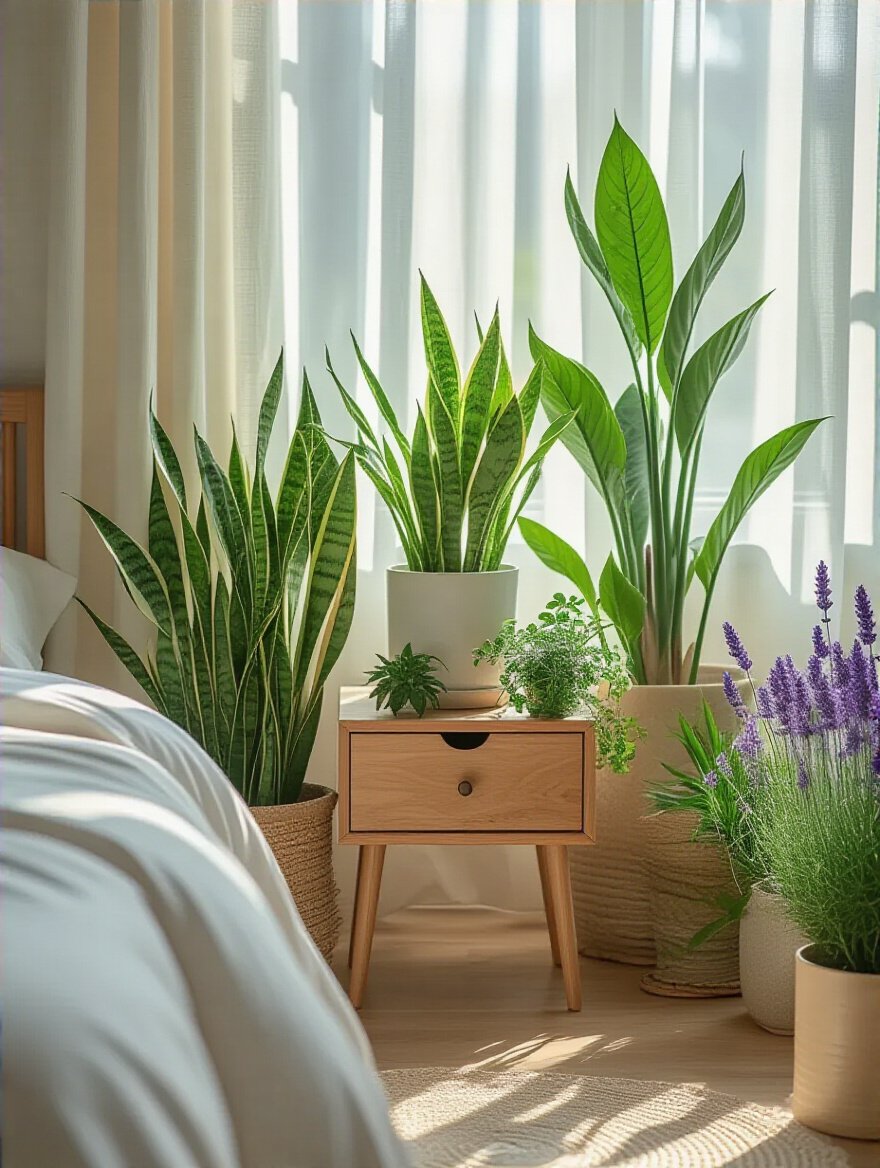
Don’t despair! There are tons of beautiful, pet-safe plants that will give you that lush, green feeling. Some of my favorites are the Spider Plant, Parlor Palm, Calathea (Prayer Plant), and Boston Fern. For a trailing look, a Hoya or a Peperomia is a great choice. Placing them in hanging planters is also a fantastic way to keep them out of reach of a curious nibbler. Plants are wonderful for our well-being, but only if they don’t pose a threat to our best friends.
The same rule applies to what we use for scent.
22. Integrate Aromatherapy or Scent for Relaxing Atmosphere
This is my other huge pet peeve. People love their essential oil diffusers, but many essential oils are highly toxic to pets, especially cats and birds. Their bodies can’t process them properly. Oils like tea tree, eucalyptus, cinnamon, citrus, and peppermint are big no-nos. Diffusing these in a room can cause respiratory distress or even liver failure.
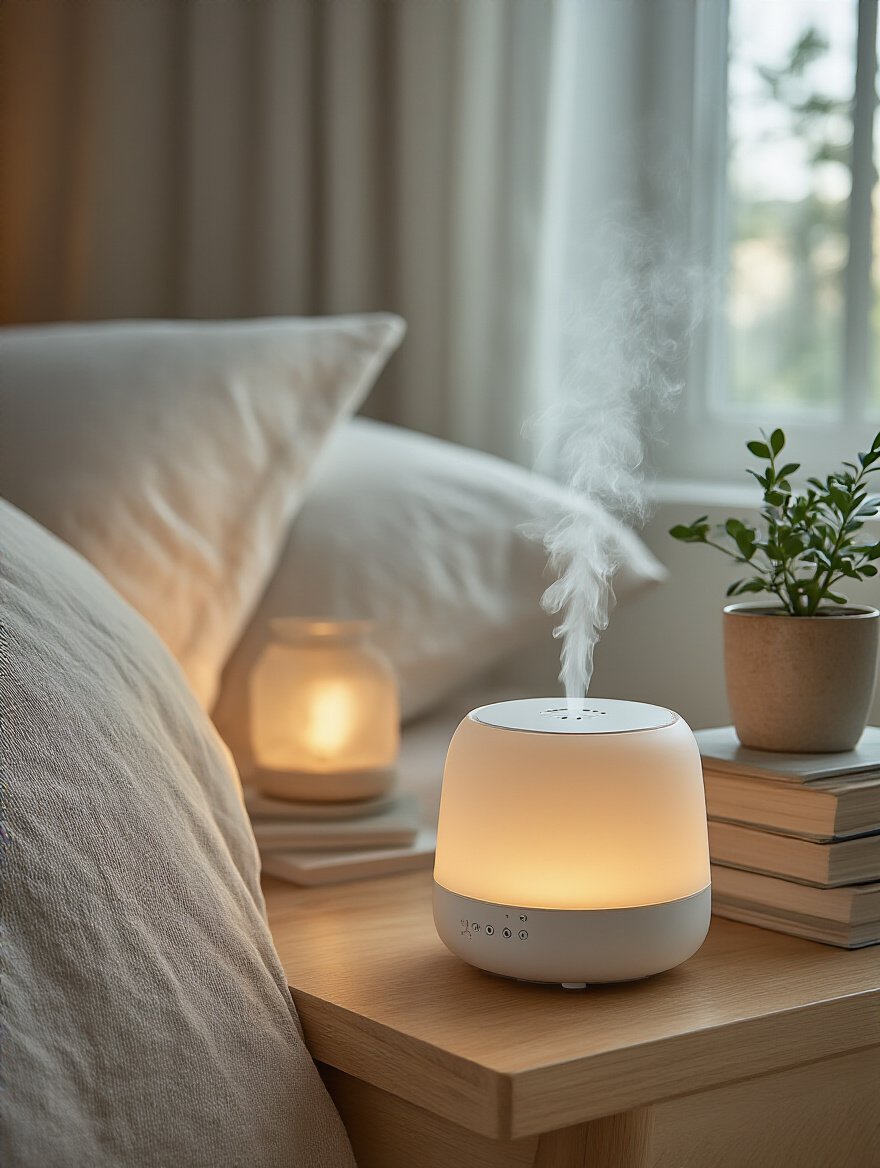
If you want to add a calming scent, do it safely. Instead of a diffuser that puts oils into the air your pet breathes, use a pet-safe linen spray on your bedding. There are some hydrosols or scents formulated specifically for pets, like lavender or chamomile, but you must check with your vet first. A much safer option is to simply open a window for some fresh air, or simmer a pot of water with a pet-safe herb like rosemary on the stove in another part of the house. Your pet’s respiratory health is more important than your bedroom smelling like a spa.
Let’s add one more dedicated zone for comfort.
23. Define a Cozy Reading Nook with Proper Seating
A reading nook is the perfect spot for quiet time. And what makes it even better? When there’s room for two—you and your pet. When you’re choosing a chair, think durable. A performance fabric or even a top-grain leather (which develops a beautiful patina and is surprisingly resistant to claws) is a smart choice.
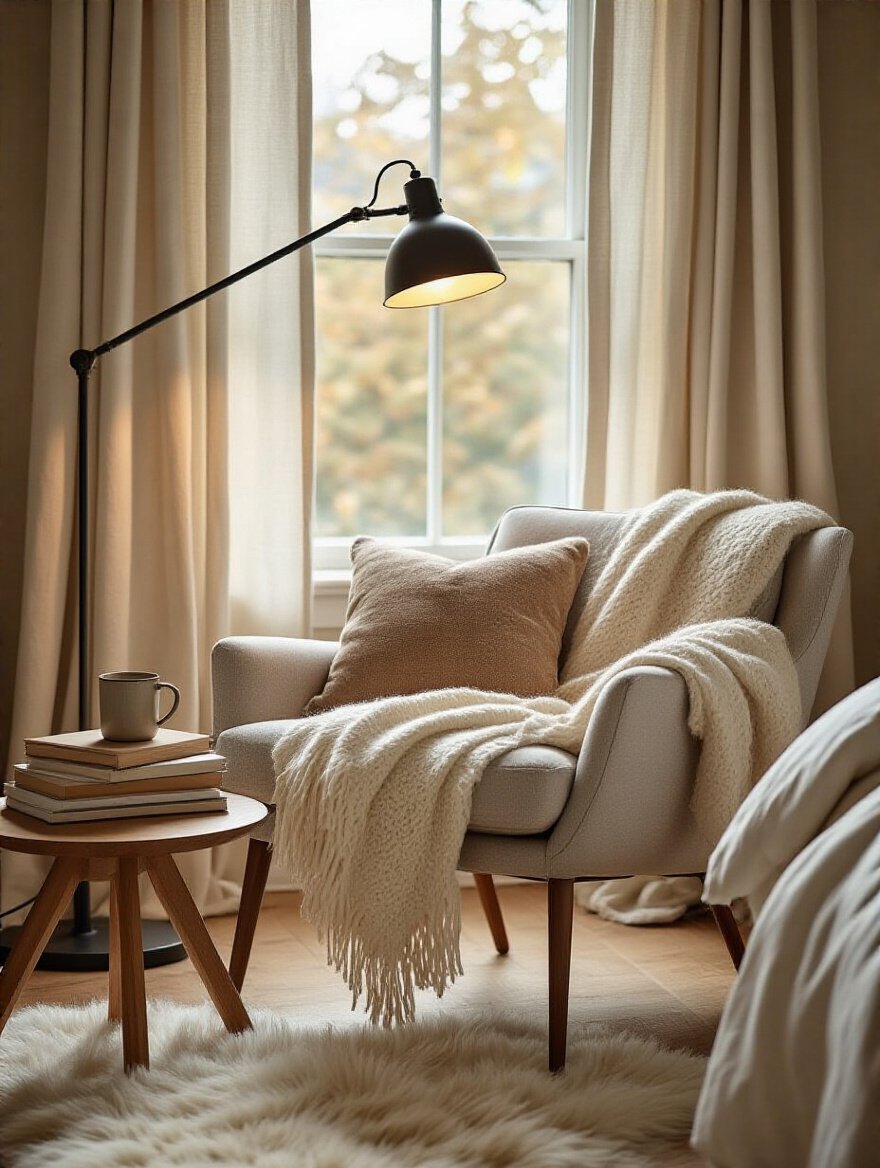
Make the space an invitation for you both. Get an armchair that’s wide enough for your cat to curl up next to you, or place a super-soft pet bed right at your feet so your dog can be close. Add a soft, washable throw over the chair. It becomes your spot, together. One client built a low, wide window seat for their nook. It was their reading spot, but it also became the perfect perch for their two Corgis to watch the world go by.
And for the final touch…
24. Upgrade Outlet and Switch Plates for a Modern Aesthetic
This might seem like it has nothing to do with pets, but hear me out. Upgrading your outlets gives you a chance to install tamper-resistant (TR) receptacles. They were designed for kids, but they’re equally brilliant for preventing a curious puppy from sticking their wet nose or tongue where it doesn’t belong.
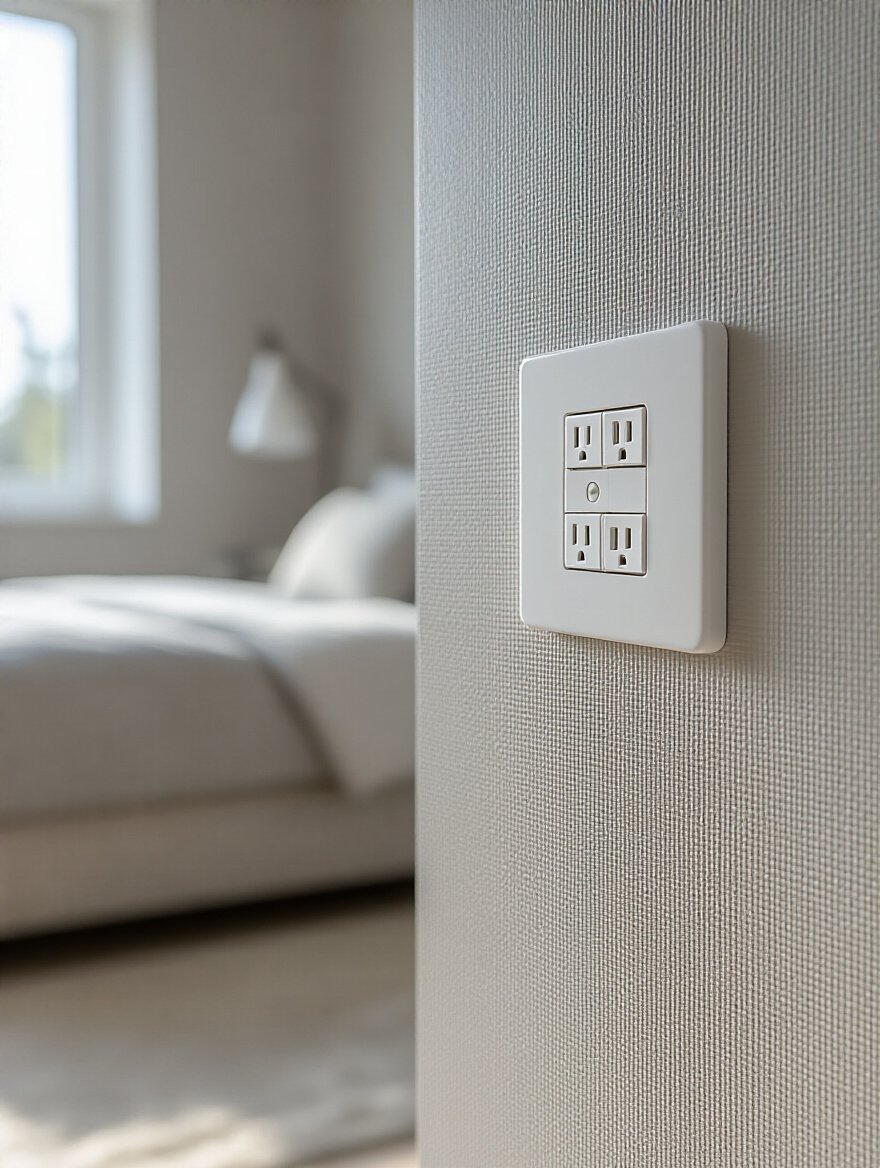
While you’re at it, you can install outlets that have built-in USB ports. This eliminates the need for those little charging blocks, which are the perfect size to be swallowed by a dog. It’s a tiny, inexpensive upgrade that makes your room look cleaner and more modern, but it also cleverly removes a couple of common household hazards. It’s the perfect example of how the safest design is often the most stylish, too.
Conclusion
A bedroom remodel isn’t just about paint colors and furniture. It’s an act of love. It’s about creating a space that nurtures you after a long day, but also one that honors the creatures who share your life and give you so much joy. The best designs don’t force you to choose between your style and their safety, or your comfort and their happiness. They weave them together seamlessly.
By planning with their needs in mind—from the floor plan to the flooring material, from the cordless blinds to the non-toxic plants—you’re not making compromises. You’re making smarter, more compassionate choices. You’re creating a space that works for every member of the family. So go ahead, dream big. Plan that beautiful sanctuary. But do it with your best friend in mind. The result will be a room that not only looks incredible but feels like home in the truest sense of the word. A place where you can both rest easy.
